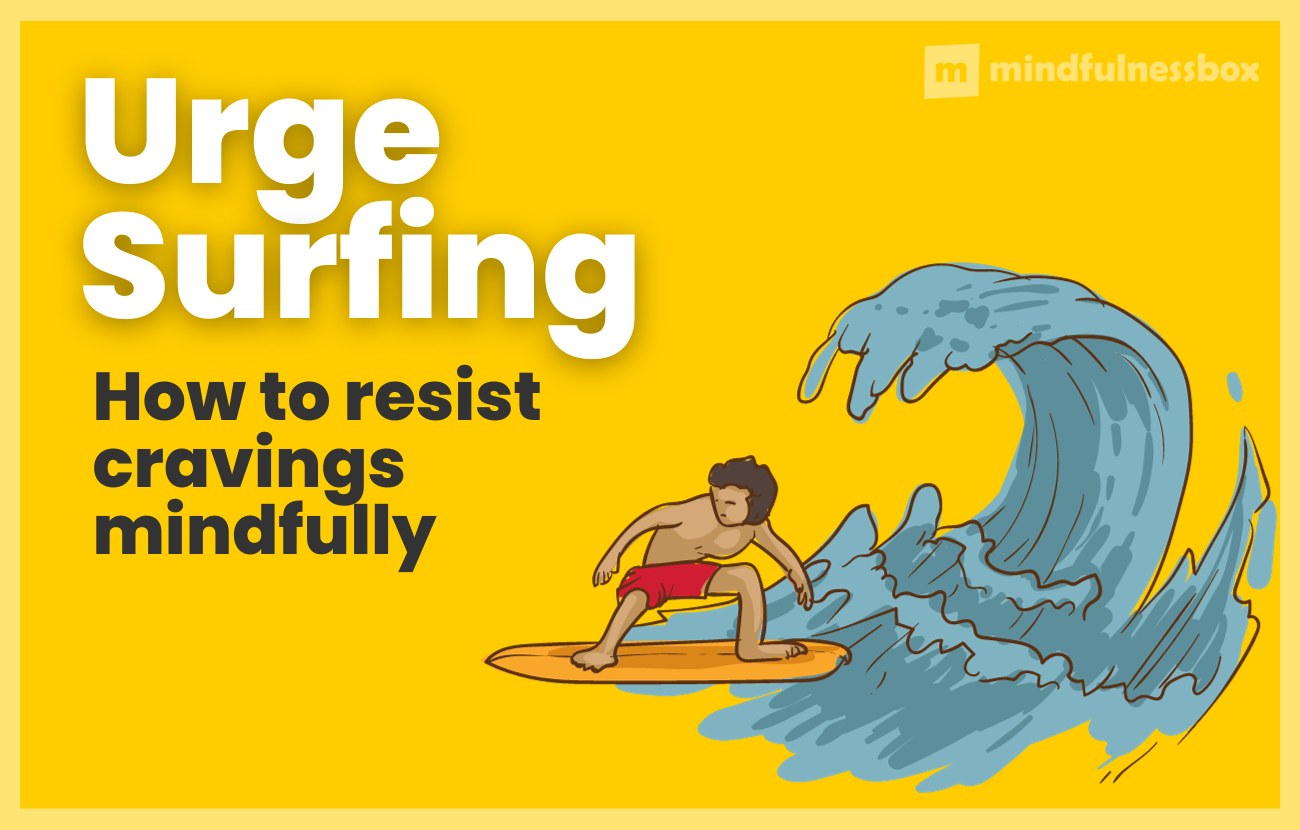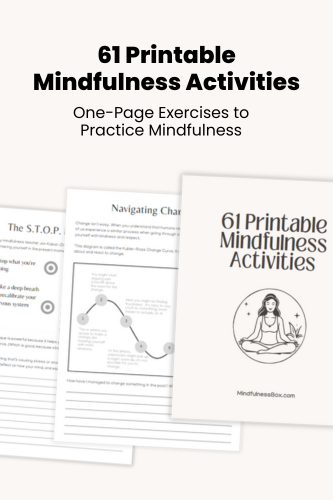Urge surfing is a way to create a mindful pause between cravings and action by “riding the wave” of your urges as they rise and subside. By surfing urges instead of acting on them right away, you can give yourself a chance to choose the action you want to take, rather than doing it on autopilot.
Not long ago, when I fasted for 24 hours as an experiment, I had a realization.
First, I got hungry around my normal mealtime. Then, as I passed mealtime and ate nothing, I got really hungry.
Get dozens of one-page exercises to help practice mindfulness, meditation, gratitude, and self love. Perfect for printable handouts when teaching mindfulness to groups, students, or in the workplace.
To see examples, plus a full list of the 61 exercises included, click below.
But then, a couple hours later, I noticed something odd – I wasn’t that hungry anymore. I “rode the wave” of my hunger to the peak, then back down again until I no longer felt like my hunger was an emergency. Instead, I felt fine.
Psychologist Dr. Alan Marlatt developed the concept of urge surfing as a metaphor to visualize the art of resisting cravings in addiction recovery. Just as waves can be intense, cravings can be intense, too. But like waves, they usually don’t last very long.
In a study of smokers, Dr. Marlatt found that those practicing urge surfing were able to reduce their smoking by twice as much as those using willpower alone.
Just as in other mindfulness practices, the goal isn’t to distract yourself from your thoughts and cravings. Rather, it’s to accept your thoughts and feelings while giving yourself time to manage them so they don’t control you.
What is urge surfing?
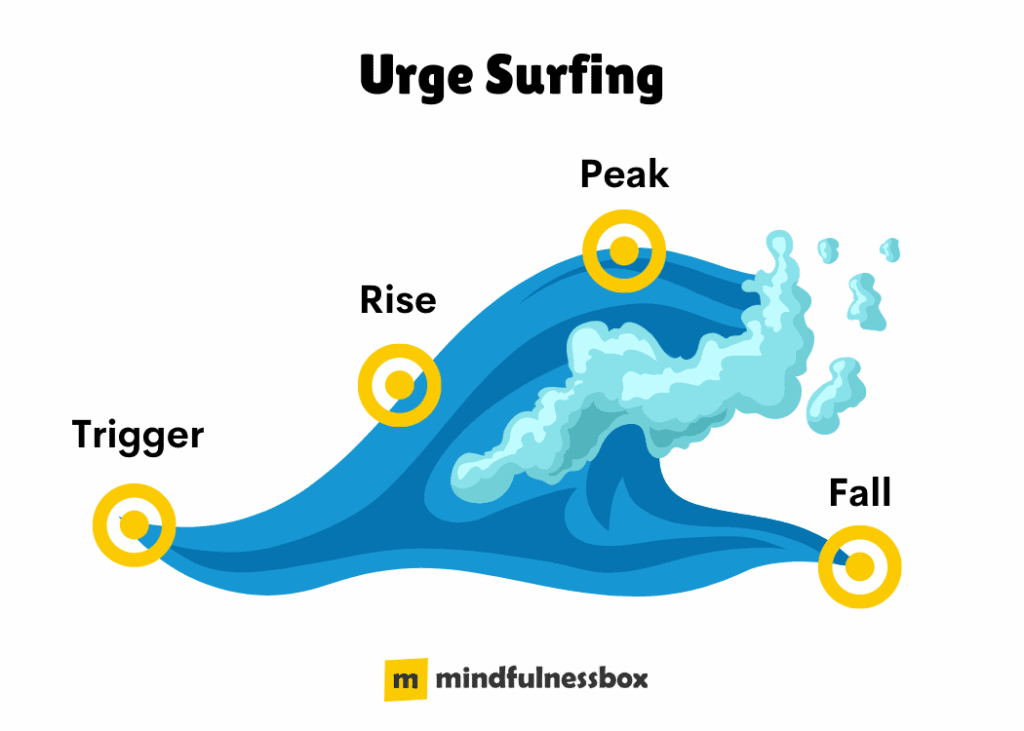
Every day, thoughts, feelings, urges, and cravings run through your mind.
You don’t choose to act on all of these cravings. But some of them are so strong that you may suddenly find yourself in front of the pantry eating snacks for no reason. You simply had a craving, then acted on it.
Urge surfing is a technique that helps you to manage cravings mindfully, by feeling the urges fully rather than attempting to distract yourself.
And, as in the snacks example above, urge surfing is often used by people who are working to eat more mindfully. It’s also commonly used for addiction recovery, among many other applications, but it can even be used for something as simple as managing the urge to watch television instead of work.
Here’s how to urge surf:
- Trigger: This is the inciting incident that causes your craving to emerge. Sticking with the food example, let’s say the trigger is seeing freshly-baked cookies in the kitchen.
- Rise: After the trigger, the urge kicks in and feelings of craving increase rapidly.
- Peak: The peak is the point of maximum craving.
- Fall: After the peak, you’ll notice that your urges start to decline until they’re eventually no longer there.
How long does an urge last? Urges can last any length of time, but if you are able to avoid ruminating on them and instead simply watch the wave pass by, they should dissipate in 15-30 minutes.
What are urges?

Observing your urges, rather than acting on them right away, can be a curious experience at first. It can also be empowering.
Acting on urges immediately can make it feel like you’re captive to your cravings. Observing and managing them gives you back the control.
Here are a few things to remember about urges:
- It’s OKAY to have urges. They’re a normal part of the human experience.
- Don’t try to resist or “talk yourself out” of an urge. That is likely to make it stronger.
- Urges are temporary. They will subside.
- You don’t have to act on urges. They’re simply feelings.
- It’s uncomfortable to observe urges without acting. Try to sit with the discomfort.
- Urge surfing is a skill. As you practice, you can get better at it.
- You won’t be successful at “surfing the urge” every time. Sometimes, you may give in. That’s okay. Be proud of yourself for trying, and try again next time.
- Self-blame and shame may be a part of your experience of cravings. Remind yourself that you’re doing your best, and release yourself from any negative self-talk.
How to stop urges in 5 Steps
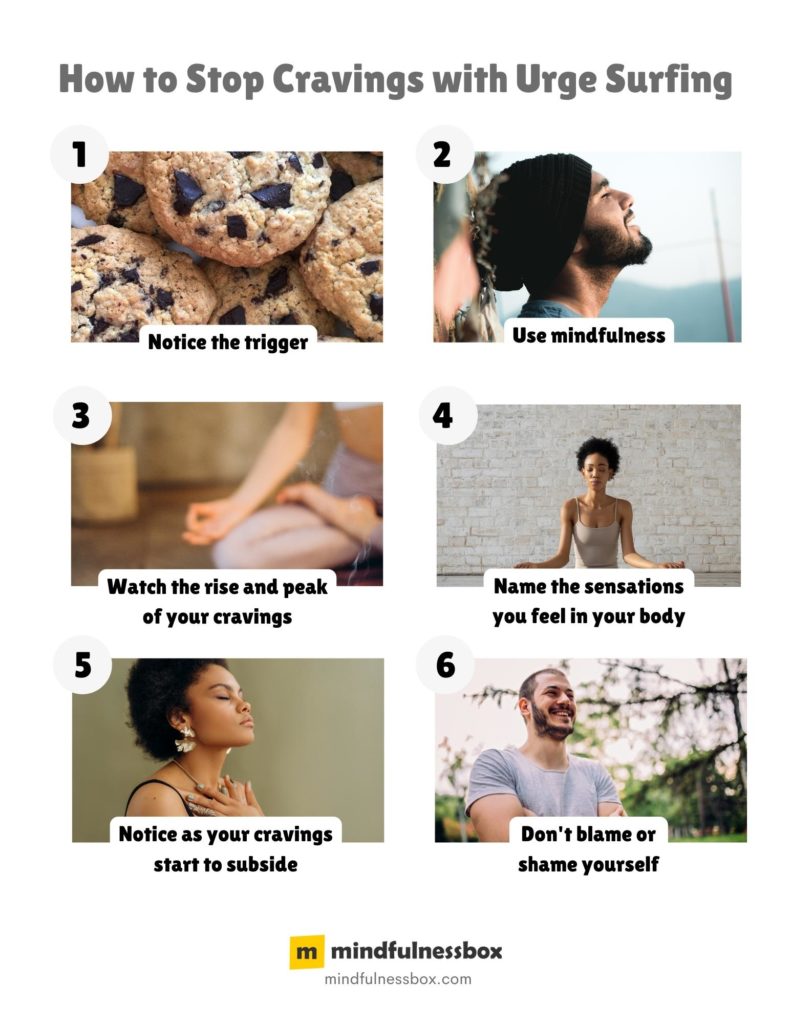
To stop cravings, urge surfing is an invaluable tool.
- Notice the trigger: Cravings start with a trigger. As you start to experience a craving, notice what triggered you to feel that urge. Cravings all come from somewhere.
- Use mindfulness: Pause and start observing your thoughts and sensations mindfully and nonjudgmentally. Notice how your body feels. Watch your breath. Breathe slowly. Accept the fact that you feel a craving. Reassure yourself – it’s okay to feel cravings. They’re just feelings.
- Watch the rise and peak of your cravings: As your cravings increase in intensity, continue to focus on your breath. Observe how the urge feels within your body. Watch as the intensity of the urge changes over time.
- Name your sensations: Can you locate a specific area of the body where the urge is located? What sensations can you feel? What does it feel like? What is the intensity of each sensation?
- Notice as the feelings subside: As you observe your urge, you’ll notice the intensity subside over time. Adopt an approach of curiosity. Notice the ebb and flow as your feelings of craving come down from their peak. Observe how your body feels as this happens.
- Don’t blame or shame: Urges and cravings are often tied to deeply ingrained habits and addictions. Don’t blame or shame yourself for feeling them. Instead, accept that you’re experiencing a craving, and watch it without judgment.
Accepting your cravings vs ignoring them
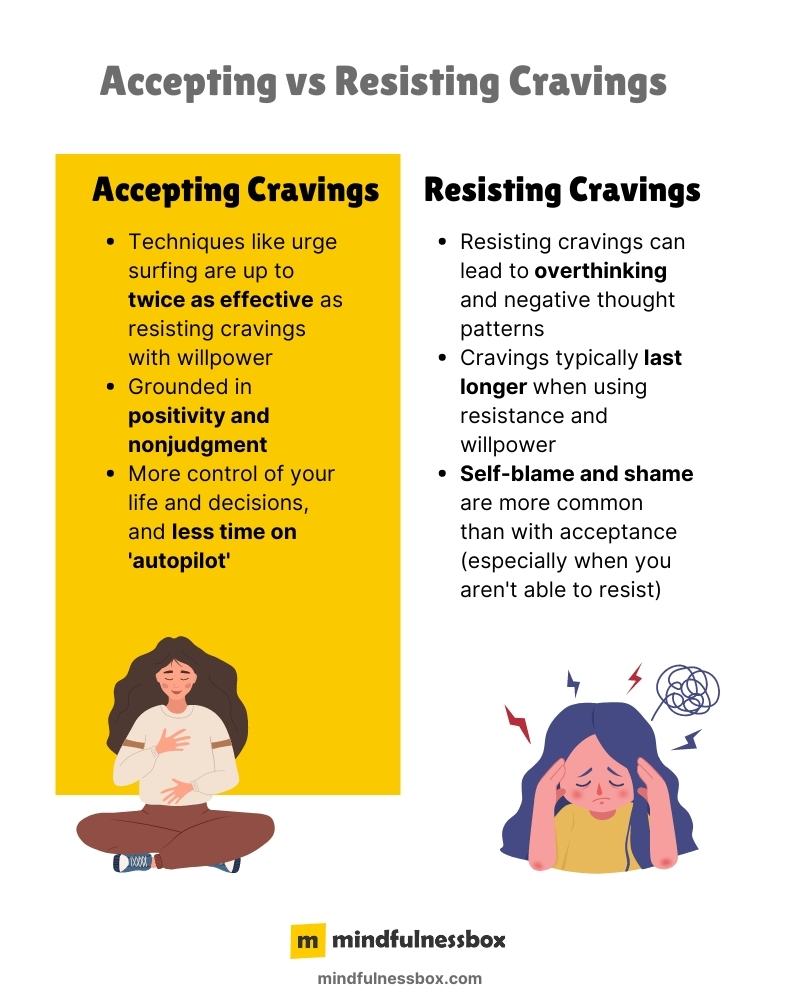
Urge surfing has been shown to be twice as effective as using willpower to resist your urges and cravings.
By ignoring or resisting your cravings, you’ll probably find that your cravings grow rather than subside. Resisting thoughts often creates a feedback loop that increases mental rumination, leading you to experience the craving for longer. It can also lead you down the path of self-blame and shame.
Instead of resisting your cravings, urge surfing is a way to accept the fact that you’re feeling them, and then watch as the feelings rise and subside.
Here’s an urge surfing example to show how this plays out in practice:
Resisting your cravings:
“Don’t think about eating cookies, don’t think about eating cookies. Why are you still thinking about cookies? You’re better than this.”
Urge surfing:
“I just saw those warm cookies, and I really want to eat them. I’m noticing the craving getting stronger and stronger. Wow – the urge is super strong. Okay, I’m feeling it go down. I’m feeling the craving less and less.”
How to surf the urge in daily life
If you’re looking for a way to stop cravings mindfully, look no further than the urge surfing technique.
Here are just a few benefits of urge surfing:
- Twice as effective as willpower: Urge surfing has been shown to be up to twice as effective as trying to resist cravings through willpower.
- Acceptance and mindfulness, not shame and blame: With urge surfing meditation, acceptance becomes a part of your daily experience, rather than the recrimination and shame that often comes with resisting cravings.
- More control, less time on autopilot: Urge surfing puts you back in the driver’s seat. Rather than acting immediately on urges, you have the chance to decide whether to act or not.
If you’re just starting out with this technique, start small, and be gentle with yourself if you struggle at first.
With practice, you’ll be urge surfing like a pro.
Further exploration
You may be interested in these related articles:

My mindfulness practice kicked off in 2016 with a ten-day silent retreat. Since then, I’ve read dozens of books about mindfulness and completed hundreds of hours of meditation. Thinking about what makes humans happy, calm, and peaceful is endlessly fascinating to me.

